Discover the incredible world of ducks in the heart of Texas! If you thought ducks were just those quacking creatures in ponds, get ready for a surprise. Texas is home to a whole bunch of duck species, way more than you might have imagined.
In this guide, we’re not just going to show you pictures and names. We’ll take you on a journey, introducing you to the cool ducks that hang out in Texas. Each duck comes with its photo ID, fun facts, and even audio recordings of their calls. So, when you’re out and about, you can impress your friends by saying, “Hey, that’s a Northern Pintail!” And yes, we’ll even give you some clever tips on identifying ducks – like figuring out ‘where is the white.’ Trust us; it’s easier than you think!
Now, let’s talk duck basics. Did you know that ducks aren’t just ducks? They belong to different duck families, and there’s even a bit of debate about it. These guys aren’t picky eaters either. Ducks love both plants and animals, munching on anything from insects and crustaceans to small fish. And get this – they’ve got these cool, pointy things called lamellae on their beaks that help them filter food through the water. It’s like having built-in food filters!
Now, let’s meet the stars of the show – the male ducks, or drakes, as we call them. They’re the fancy, colorful ones, showing off their vibrant feathers. And the ladies? Well, they’re either ducks or hens, bringing their touch of elegance to the group. Oh, and did you know that all those cute ducks you see in your local pond are descendants of the famous mallard? True story!
But wait, this guide isn’t just a bird encyclopedia. We’ve got real, juicy information. Thanks to bird-watchers and some serious bird data, we’ve got the scoop on when and where these ducks show up in Texas. From the common Mallard to the more elusive visitors, we’re your go-to source for duck gossip.
So, buckle up! We’re about to embark on a Texan duck adventure. After this, we’ll dive into the specifics, uncovering 30 different duck species making Texas their awesome home. Get ready to quack up your knowledge!
Can geese eat apples?
Types Of Ducks In Texas
30 ducks occur in Texas so we will discuss each in detail please stay connected with us and also comment on which one is your favorite
Dabbling Ducks (12 Species)
Blue-winged Teal
Blue-winged Teals, belonging to the Anatidae family, are a species of small ducks easily identifiable by their bluish-gray heads adorned with a distinctive white crescent in front of their eyes. The males exhibit a spotted brown pattern on their bodies from the chest to the tail, accompanied by a striking blue patch on the shoulders bordered with green and white when their wings are unfurled. In contrast, females maintain the scaly brown pattern but lack the distinctive white markings on their faces.
Found year-round in Texas, Blue-winged Teals make up 4% of summer and 8% of winter bird checklists submitted by avid bird watchers. These ducks breed in the US and Canada before embarking on migratory journeys to various destinations, including Florida, the Gulf Coast, the southern West Coast, Mexico, Central and northern South America, and the Caribbean.
Blue-winged Teals prefer shorelines with calm or sluggish water, making lakes and ponds with protruding trees and rocks ideal habitats. They are also commonly found around shallow water sources abundant in vegetation, such as marshes and swamps. During the breeding season, northern prairies and parklands become their primary nesting grounds.

These ducks primarily feed on aquatic plants found on the water’s surface, with a tendency to consume aquatic insects, especially during the breeding season. Nesting habits involve creating nests in hollows in the ground, sheltered behind tall grasses and near water sources. The nests, constructed from grass and weeds and lined with down, serve as incubation sites for up to fifteen eggs.
Females diligently incubate the eggs for 2 to 3 weeks, after which the ducklings hatch and can walk within a few hours. However, it takes six to seven weeks for them to gain the ability to fly. A notable characteristic of Blue-winged Teals is their long, over-ocean migration patterns, contributing to the highest mortality rate among dabbling ducks.
Northern Shoveler
Northern Shovelers, prominent in Texas from November to March and frequently observed throughout the year, exhibit distinctive characteristics that make them easily identifiable. Dabbling ducks, the males boast green heads, large spoon-shaped black beaks, reddish-brown sides, white chests, black backs, and blue patches on their wings. On the other hand, females display a mottled brown appearance with a blue shoulder patch and large orange beaks.
The scientific name, Spatula clypeata, and physical attributes such as length (17.3 – 20.1 in), weight (14.1 – 28.9 oz), and wingspan (27.2 – 33.1 in) further define these ducks. Their seasonal patterns include wintering in the southern US, along the Pacific and Atlantic Coasts up to Canada, while breeding occurs in the western half of Canada, northwestern US states, and around the Great Lakes during the summer.

Northern Shovelers are social birds often found in groups in shallow, stagnant water. Their diet consists of crustaceans, invertebrates, and seeds, filtered through their bills with comblike projections called lamellae. Notably, their calls differ between males (‘hook-hook’ or ‘took-took’) and females (nasal quack).
Nesting habits involve laying around ten eggs on the ground in short vegetation close to water, with ducklings capable of walking and swimming immediately upon hatching. A fascinating behavior includes the formation of large groups that swim in circles, aiding in stirring up the bottom for feeding.
Gadwall
In Texas, Gadwalls, recognized for their large size and distinctive coloring, are frequently observed during the winter months from November to March, constituting 13% of checklists during this period. Some Gadwalls also remain in Texas throughout the year. These ducks, identified by their dark-brown heads, black scaled patterns on the chest and shoulder, gray or white bellies, and black bottoms, stand out with a subtle appearance compared to other vibrant dabbling ducks. In flight, a distinctive small white patch on their wings is noticeable, and females exhibit a generally brown coloration with a diffused scale pattern on various parts of their bodies.
Gadwalls, scientifically known as Mareca strepera, exhibit specific attributes such as a length ranging from 19 to 23 inches (48 to 58 cm), a weight of 35.27 ounces (1000 g), and a wingspan of 31 to 36 inches (79 to 91 cm). They breed in the plains of the United States and Canada before migrating to central and southern US states and Mexico. Some populations remain on the West Coast throughout the year. These ducks are commonly found in open wetlands, grasslands, and marshes with dense vegetation. During winter, they can also be spotted in saltwater marshes, city parks, reservoirs, and muddy estuaries.

The feeding behavior of Gadwalls involves dabbling in shallow water, submerging their heads to reach for plants and vegetation underwater. Occasionally, they may feed on insects. Male Gadwalls emit short reedy whistles followed by a quack, while females quack and produce sounds similar to mallards.
The nesting behavior of Gadwalls involves hidden nests in dense vegetation near water, constructed with grass and weeds and lined with feathers. A single nest may contain as many as fifteen eggs, and the female incubates them for approximately twenty-seven days until hatching.
A unique aspect of Gadwall’s behavior is their occasional food stealing from other dabbling ducks as they surface from diving.
Key information about Gadwalls in Texas includes their prevalence during winter, distinctive coloring, habitat preferences, migration patterns, feeding and nesting behaviors, and specific attributes such as size and markings.
Mallard
In Texas, Mallards, a species of ducks, are a common sight throughout the year. These ducks, characterized by their striking green heads, bright yellow bills, and distinctive markings such as a blue patch on the wings called a speculum, are frequently observed in 4% of summer and 8% of winter checklists. The males boast vibrant colors, while females and juveniles exhibit a mottled brown appearance with orange bills and retain the characteristic blue speculum.
Mallards, scientifically known as Anas platyrhynchos, have specific physical dimensions, with a length ranging from 19.7 to 25.6 inches, a weight of 35.3 to 45.9 ounces, and a wingspan of 32.3 to 37.4 inches. They are prevalent not only in Texas but also in most of the lower 48 states, the western coast of Canada, and Alaska. Those breeding in Canada and Alaska migrate south to the southern United States and northern Mexico.
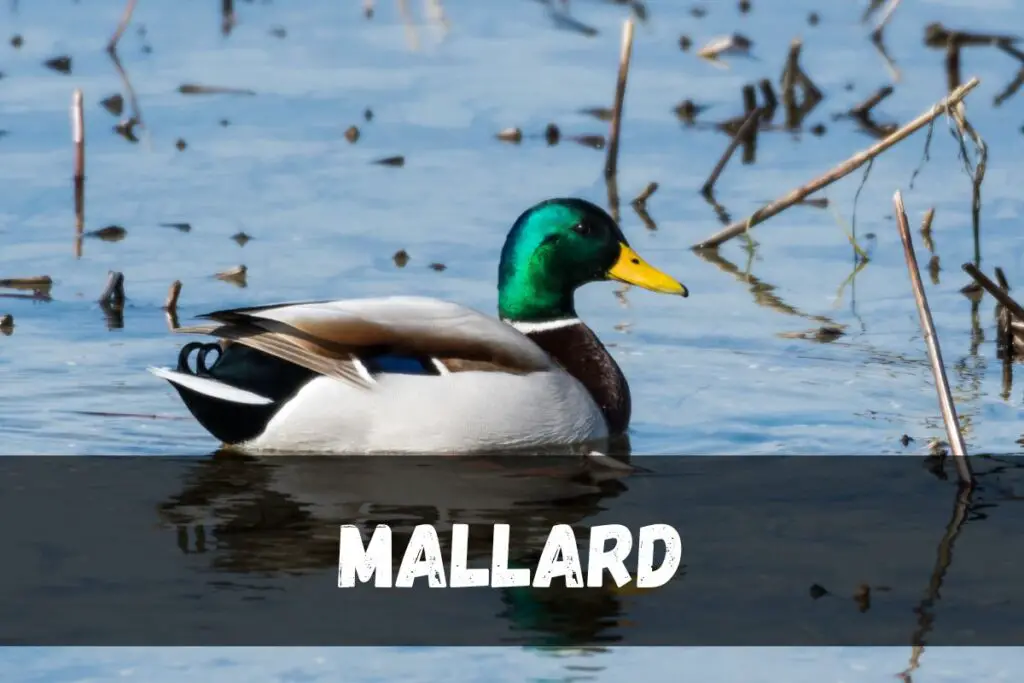
These ducks, often found on ponds and rivers, are dabbling ducks that feed on water plants without diving. They are known for their longevity, with some individuals recorded to live up to 27 years. Interestingly, male Mallards make rasping sounds instead of quacking, a behavior distinct from females.
Nesting
Mallards build their nests on the ground, close to the water, concealed under overhanging grass. The nests, made in depressions on the ground and filled with vegetation from the surroundings, typically contain up to thirteen eggs. The eggs take about 3 to 4 weeks to hatch, and the ducklings are ready to leave the nest almost immediately.
Food
Mallards are known to be easily fed on ponds and rivers. Finally, a fascinating fact is that most domesticated ducks are descendants of Mallards, and these ducks have been historically hunted and bred for food.
Key Information:
- Distribution: Texas, the lower 48 states, the western coast of Canada, Alaska, the southern United States, and northern Mexico.
- Physical Characteristics: Green heads, yellow bills, mottled brown appearance (females and juveniles), speculum on wings, specific dimensions.
- Behavior: Dabbling ducks, non-divers, long-lived, rasping sounds (males), nesting on the ground, hidden nests, up to thirteen eggs, domestication history, hunted and bred for food.
Green-winged Teal
The Green-winged Teal, a species of small dabbling ducks, is prominently found in Texas during the winter months, spanning from September to April. Approximately 9% of checklists during this period include sightings of these ducks. The males boast a distinctive green stripe along the sides of their heads, accompanied by brown heads and grayish bodies. In contrast, females exhibit brown plumage with a yellow streak along the tail, and both genders feature a distinctive green wing patch.
These ducks, scientifically known as Anas crecca, are characterized by a specific set of physical dimensions: a length ranging from 12.2 to 15.3 inches, a weight between 4.9 and 17.6 ounces, and a wingspan of 20.5 to 23.2 inches. The Green-winged Teals engage in migratory patterns, traveling from breeding grounds in Alaska, Canada, and northern US states to the southern US states and the Pacific Coast. However, some individuals opt to remain around the Rocky Mountains throughout the entire year.

Green-winged Teals congregate in large flocks of up to 50 thousand on flooded grounds and shallow ponds. Their diet consists of invertebrates and seeds. Nests, where they lay up to 9 eggs, are typically situated on the ground in dense cover such as grass or thickets. The ducklings are quick to leave the nest almost immediately after hatching.
Vocalizations,
Male Green-winged Teals emit whistles and chatter, while females produce a high-pitched quack. Interestingly, these ducks possess the ability to take off directly from the water without the need to run across the surface due to their agility.
Food:
Green-winged Teals feed on a diet of invertebrates and seeds, utilizing flooded grounds and shallow ponds for foraging.
Nesting:
The nests of Green-winged Teals are situated on the ground in dense cover, including grass or thickets. They lay up to 9 eggs, and the ducklings are ready to leave the nest shortly after hatching.
Fulvous Behavior:
Male Green-winged Teals exhibit whistling and chattering behavior, while females are known for their high-pitched quack.
Key Information
The Green-winged Teal, with its distinctive green wing patch and migratory habits, is a small dabbling duck found in Texas during winter, known for its agility in flight and unique nesting habits in dense covers near water bodies.
American Wigeon
American Wigeons, a species of small ducks, are commonly found in Texas during the winter months, spanning from September to May. They make up 7% of birdwatching checklists during this period. Identified by their distinctive green stripes on the sides of the males’ heads and white caps, these ducks exhibit grayish-brown coloring in the rest of their bodies, while females have brown with grayish-brown heads and both genders feature pale beaks.
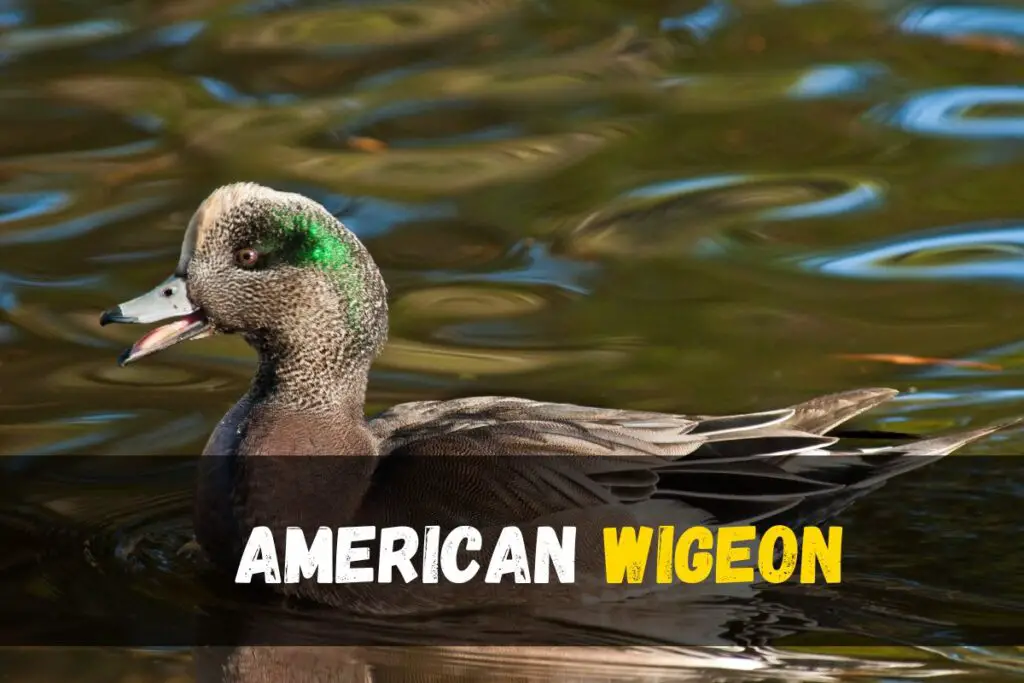
Size
American Wigeons range from 16.5 to 23.2 inches in length, weigh between 19.1 and 46.9 ounces, and boast a wingspan of 33.1 inches. They primarily breed in Alaska, western Canada, and northwestern US states, migrating to southern and central US states and the coasts of the Pacific and Atlantic oceans for the winter.
American Wigeons are versatile feeders, foraging on vegetation in water and land in various habitats such as wetlands, fields, and ponds. Their diet also includes insects and invertebrates. The males are known for emitting a high-pitched whistle, while females produce a harsh grunt.
Nesting
American Wigeons build their nests on the ground, away from water, typically in fields and grasslands. The female lines the nest with grass, reeds, and down feathers, laying up to 13 eggs that take 2 to 3 weeks to hatch. The ducklings leave the nest shortly after hatching.
A fascinating tidbit about American Wigeons is their nickname, ‘baldpate,’ derived from the resemblance of their white stripe to a bald man’s head.
Northern Pintail
In Texas, the Northern Pintail is a prevalent species of duck, observed throughout the year but particularly prominent from November to February, constituting approximately 7% of winter checklists. These ducks, recognized for their long pointy tails, exhibit distinct sexual dimorphism. Males boast a beautiful brown head with a contrasting white vertical stripe down their neck, while females are characterized by intricate scaled patterns on their brown bodies.
Northern Pintails can be found cohabiting with various duck species in diverse habitats such as open wetlands, marshes, prairies, and even agricultural fields. During winters, they migrate to coastal lagoons, sheltered estuaries, and brackish marshes. Their foraging behavior is notable, as their long necks allow them to reach depths of up to 12 inches in water, giving them a unique advantage over other ducks. They primarily feed on seeds, and roots of aquatic vegetation, and, during the breeding season, incorporate animals like aquatic insects and mollusks into their diet for protein.
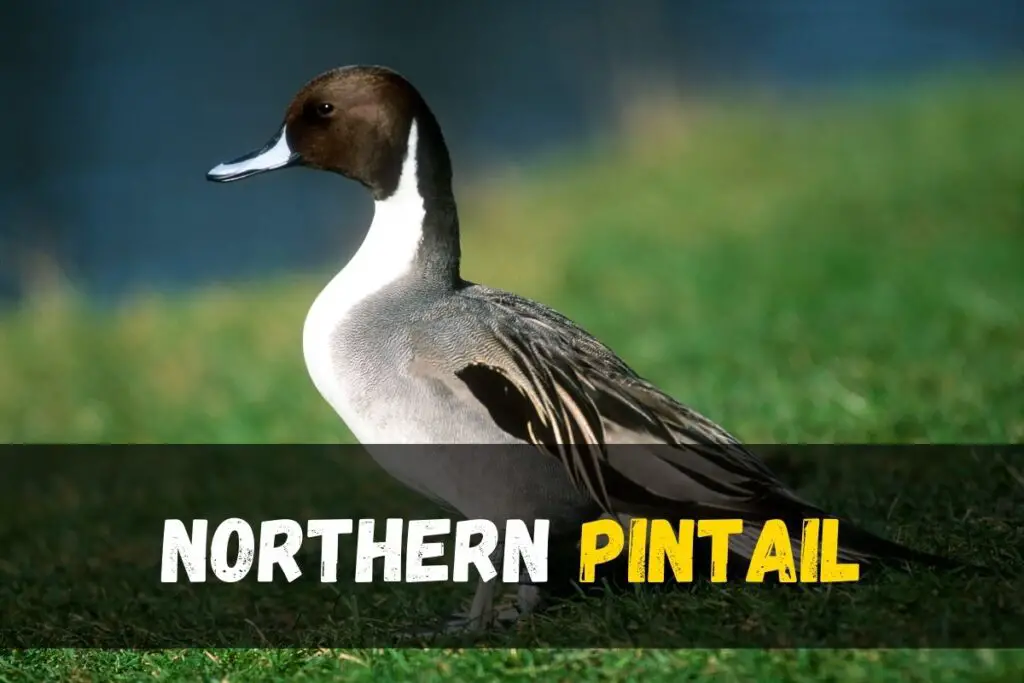
Nesting habits of Northern Pintails involve shallow hollows on the ground close to water sources. The nests, constructed with grasses and feathers, provide a home for at least twelve eggs. The female diligently incubates the eggs for around twenty-five days, and upon hatching, leads the young to water for independent feeding. The ducklings achieve flight capability in approximately fifty days but remain in the nest until the female completes molting.
A fascinating aspect of Northern Pintails is their agile and speedy nature, making them a challenging target for game shooting enthusiasts in the region.
Food:
Northern Pintails are versatile feeders, consuming seeds and roots of aquatic vegetation, as well as seeds and grain from agricultural fields. During the breeding season, their diet includes a higher proportion of animals like aquatic insects and mollusks, providing essential protein.
Nesting:
The nests of Northern Pintails are typically shallow hollows on the ground, constructed with grasses and feathers. These nests, positioned close to water sources, serve as a safe haven for at least twelve eggs. The female takes on the responsibility of incubating the eggs for as many as twenty-five days.
Fulvous Behavior:
Northern Pintails exhibit agile and speedy behavior, which makes them a challenging and sought-after target for game shooting enthusiasts in Texas. Their ability to dabble in open water, forage in diverse habitats, and migrate to different environments showcases their adaptability and versatility.
Key Information:
The key information about Northern Pintails in Texas includes their year-round presence, prominence from November to February, and their distinctive physical characteristics. Their foraging behavior, nesting habits, and migration patterns also contribute to the overall understanding of these ducks in the region. Additionally, the challenges posed by their agility make them a notable species in the context of game shooting.
Wood Duck
Wood Ducks, scientifically known as Aix sponsa, are a captivating species found in Texas throughout the year. The male Wood Ducks stand out with their vibrant green heads, striking crests, and distinctive black and white markings, not to mention their captivating red eyes. In contrast, the females exhibit a more understated appearance with brown and grayish-brown tones, featuring white around their dark eyes and distinctive blue patches called speculum on their wings.
These ducks, ranging from 18.5 to 21.3 inches in length, are not only aesthetically pleasing but also possess interesting nesting and migratory behaviors. Wood Ducks are residents of eastern US states, the Pacific Coast, and parts of the northwest. Those breeding in northern regions along the Canadian border migrate to southern US states and Mexico for winter.

Wood Ducks primarily inhabit wooded swamps, demonstrating a versatile diet that includes seeds, fruit, and insects, both in water and on land in fields and forests. Their nests, usually located in tree cavities, are strategically close to water and can reach heights of up to 60 feet above the ground. Female Wood Ducks line the nests with down feathers plucked from their breasts, laying up to sixteen eggs that take 4 or 5 weeks to hatch. Interestingly, the young use their clawed feet to climb out before taking the bold leap.
A fascinating aspect of Wood Duck’s behavior is the propensity of females to lay their eggs in other Wood Duck nests, leading to a communal upbringing by other ducks.
Key Information:
- Physical Characteristics: Male Wood Ducks boast beautiful green heads, striking crests, and black and white markings, while females have a more subdued appearance.
- Geographical Distribution: Wood Ducks are residents of eastern US states, the Pacific Coast, and parts of the Northwest.
- Habitat: They can be found in wooded swamps, fields, and forests.
- Diet: Wood Ducks consume seeds, fruit, and insects, both in water and on land.
- Nesting Behavior: Nests are usually in tree cavities, close to water, and up to 60 feet above the ground. Females line the nests with down feathers.
- Reproductive Cycle: Females lay up to sixteen eggs, which take 4 or 5 weeks to hatch. The young use their clawed feet to climb out before jumping.
- Migration: Wood Ducks breeding in northern regions migrate to southern US states and Mexico for winter.
- Communal Behavior: Female Wood Ducks often lay their eggs in other Wood Duck nests, leading to communal upbringing by other ducks.
Cinnamon Teal
Cinnamon Teals, a captivating species of waterfowl, grace the skies and freshwater habitats of Texas throughout the year, with their presence becoming more pronounced from November to April, constituting 2% of winter checklists. These ducks, scientifically known as Spatula cyanoptera, exhibit a striking transformation during the breeding season. Breeding males don a remarkable cinnamon-colored plumage, featuring red eyes, a scaly reddish-brown patch on their backs, a pale blue shoulder, and a distinctive white line separating it from the greenish lower wing.
During this period, males attract attention with their vibrant appearance, but they undergo molting in winter, resembling females with brown hues and scaly patterns. The physical characteristics of Cinnamon Teals include a length of 14-17 inches, a weight of 16.4 ounces, and a wingspan ranging from 24 to 30 inches.

These ducks breed in western US states and southwestern Canada before embarking on a winter migration to Mexico and South America. Noteworthy is the fact that some individuals choose to remain in southwestern US states, Mexico, and South America throughout the year. Their habitat of choice includes freshwater marshes and ponds, aligning with their classification as members of the Dabbling Duck family, indicative of their surface-skimming feeding habits. Cinnamon Teals sustain themselves by consuming seeds, plants, and aquatic insects, often opting to dabble just below the water’s surface, particularly in shallow areas.
Nesting
Cinnamon Teals display a preference for building their nests on the ground, strategically nestled among tall grasses and vegetation near water sources. The nests, crafted with soft grass and down, may contain up to twelve eggs, requiring a roughly twenty-five-day incubation period before hatching. Remarkably, after a mere fifty days, the young Cinnamon Teals achieve the ability to fly independently.
An intriguing aspect of Cinnamon Teals’ behavior is their penchant for changing breeding partners annually, adding a unique dynamic to their reproductive cycle. In essence, Cinnamon Teals contribute to the rich avian diversity in Texas, offering both visual delight and ecological significance.
Key Information:
- Food: Cinnamon Teals primarily feed on seeds, plants, and aquatic insects, employing their dabbling behavior to skim the water’s surface, especially in shallow areas.
- Fulvous Behavior: Notably, Cinnamon Teals exhibit fulvous behavior by changing breeding partners every year, adding a distinctive element to their reproductive practices.
Mexican Duck
In Texas, one can encounter the unique and interesting Mexican Duck (Anas Diaz). These ducks exhibit minimal sexual dimorphism, with both males and females sharing a resemblance to the female Mallard. Notably, the key distinguishing feature between male and female Mexican Ducks lies in the coloration of their bills – the male’s bill is dull yellow, while the female’s is mottled in black and orange, reminiscent of a Mallard.
During flight, differentiating between a Mallard and a Mexican Duck becomes discernible by examining the speculum. The Mallard sports a single white band, whereas the Mexican Duck boasts two distinctive white stripes, providing a subtle yet measurable difference.

The intriguing aspect of Mexican Ducks in Texas is their breeding behavior. They readily breed with Mallard Ducks, contributing to the challenge of identifying their offspring. These ducks exhibit seasonal behavior, serving as winter residents in South Texas and maintaining a year-round presence in North Texas.
Food:
Mexican Ducks, like many waterfowl, have diverse dietary preferences. Their diet typically includes aquatic plants, seeds, and small invertebrates found in wetland habitats. Their foraging behavior is adapted to their surroundings, allowing them to thrive in the varied ecosystems of Texas.
Nesting:
The nesting habits of Mexican Ducks involve the creation of nests in concealed locations near water bodies. The female takes the lead in building the nest, often using vegetation and down feathers to line the interior. Nesting sites are chosen with care to provide a secure environment for incubating eggs and raising ducklings.
Fulvous Behavior:
Mexican Ducks display fulvous behavior, especially during the breeding season. This behavior is characterized by courtship displays, vocalizations, and interactions between mating pairs. Understanding fulvous behavior is crucial for identifying and studying the reproductive dynamics of Mexican Ducks.
Key Information:
Key information about Mexican Ducks in Texas includes their size, with a length ranging from 20 to 22 inches and a wingspan of 32.3 to 37.4 inches. They weigh around 25.5 ounces. The close resemblance to Mallards and the subtle differences in bill coloration and speculum markings make their identification a fascinating challenge for bird enthusiasts in the region. Additionally, the seasonal residency pattern, breeding habits, and dietary preferences contribute to the rich tapestry of Mexican Duck ecology in Texas.
Muscovy Duck
In Texas, the Muscovy Duck, scientifically known as Cairina moschata, is a prominent species. These ducks, native to North America, particularly inhabit the southern edge of Texas, including the Gulf Coast. Wild Muscovy Ducks extend their habitat further south into Mexico and South America. Meanwhile, domesticated Muscovy Ducks can be found in various environments such as cities, ponds, and farms across North America.

Key Information about Muscovy Ducks in Texas:
- Length: Muscovy Ducks measure between 26 to 33 inches (66 to 84 cm).
- Weight: They typically weigh between 2.4 to 9.0 pounds (1.1 to 4.1 kg).
- Wingspan: The wingspan ranges from 54 to 60 inches (137 to 152 cm).
- Appearance: The male Muscovy Duck is the largest and heaviest among North American ducks, characterized by large white patches on its wings. The female, smaller in size, also exhibits black plumage with some white patches.
- Habitat: Wild Muscovy Ducks thrive along the southern edge of Texas, while their domesticated counterparts can be found in urban areas, ponds, and farms.
Regarding their behavior and characteristics:
- Food: The diet of Muscovy Ducks varies, including aquatic vegetation, insects, and grains.
- Nesting: Muscovy Ducks are known to build nests in secluded areas, often utilizing natural materials.
- Fulvous Behavior: These ducks have red facial skin and may develop irregular red growths resembling warts on their faces.
Mandarin Duck
The Mandarin Duck, scientifically known as Aix galericulata, is an exceptionally stunning species that stands out among the diverse ducks found in Texas. Measuring between 16 to 19 inches and weighing around 17.7 to 20 ounces, these ducks boast a wingspan ranging from 25.5 to 29 inches. Their vibrant appearance includes a palette of colors such as orange, purple, blue, white, yellow, black, and green, particularly prominent in males. Male Mandarin Ducks are further characterized by “sail fins” on their backs and a charming red bill with a pale tip.
Encountering a Mandarin Duck in Texas is a rare and noteworthy event, as highlighted by a documented sighting in Harlingen Park in 2022, which even made the news. These ducks, being migrants, contribute to the unpredictability of their presence in the region.
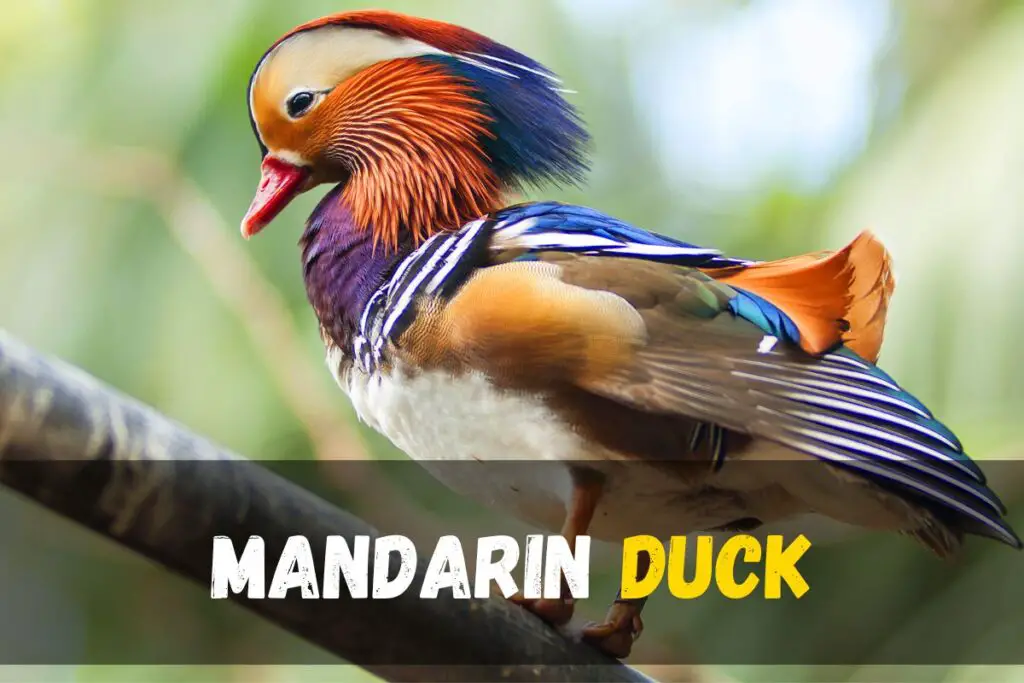
The females, although less flamboyant than their male counterparts, exhibit their unique features. They are mostly brown with a dappled chest and a shaggy head. Notably, females possess a distinctive white ring around their eyes and a thin stripe running from the eyes to the back of the head.
Understanding the behavior and characteristics of Mandarin Ducks in Texas involves considerations beyond their appearance. Predicting their presence is challenging due to their status as rare migrants, adding an element of excitement to any potential sightings.
Key Information:
- Food: Specific details about the Mandarin Duck’s diet in Texas are not provided in the given content. However, like other ducks, they typically feed on a variety of aquatic plants, insects, and small aquatic animals.
- Nesting: The information about the nesting habits of Mandarin Ducks in Texas is not explicitly mentioned. However, it’s known that they prefer nesting in tree cavities or nest boxes near water.
- Fulvous Behavior: The term “fulvous behavior” is not directly mentioned in the given content. If there is a specific aspect of behavior you are looking for, please provide more details or clarify.
- Key Information: The key information about Mandarin Ducks in Texas revolves around their stunning appearance, rarity as migrants, unpredictability in presence, and a documented sighting in a Harlingen park in 2022.
Diving Ducks (8 Species)
Mottled Duck
In Texas, one can find the unique and captivating Mottled Ducks (Anas fulvigula), distinctive for their rich brown bodies, buffy heads, and bright yellow bills. Unlike many duck species, Mottled Ducks exhibit minimal sexual dimorphism, with both males and females featuring streaked feathers in light and dark brown. The females, albeit slightly muted compared to males, possess bills with a hint of green.
These ducks are primarily inhabitants of Florida, Louisiana, and Texas, with a particular affinity for the year-round residency in Texas’s Gulf Coast region. Mottled Ducks are often spotted in pairs or small groups rather than large flocks, a behavior that contributes to their unique charm.

However, their survival faces significant threats, notably from the release of numerous pet Mallards in Florida and the southeast. The interbreeding of these feral Mallards with Mottled Ducks dilutes the wild population of the latter, posing a challenge to their existence.
Food:
Mottled Ducks prefer shallow fresh or brackish wetlands, and you can commonly find them in roadside ditches and impoundments with water levels of 6 inches or less. This habitat choice aligns with their distinctive feeding habits, making them easy to spot in these environments.
Nesting:
The nesting behavior of Mottled Ducks involves selecting areas in proximity to shallow water. Their nests, likely well-hidden, are situated in the wetlands they favor, reflecting their adaptation to specific environmental conditions.
Fulvous Behavior:
The Audubon Society notes that Mottled Ducks are rarely seen in large flocks. Instead, they exhibit fulvous behavior, generally traveling in pairs or small groups. This behavior is not only a testament to their unique social structure but also contributes to their vulnerability, given the threats they face.
Key Information:
A key point of concern for the conservation of Mottled Ducks is the hybridization with pet Mallards. The Audubon Society emphasizes the negative impact of feral Mallards on the wild population of Mottled Ducks, urging attention to the release of these domesticated birds as a critical factor affecting the species’ survival. Understanding and addressing these threats are essential for the preservation of the Mottled Duck population in Texas and beyond.
Lesser Scaup
In Texas, one can encounter the fascinating Aythya affinis, commonly known as Lesser Scaups, during the winter months. These diving ducks, with a length ranging from 15 to 18 inches and a wingspan of 24 to 33 inches, are frequently spotted in freshwater ponds, lakes, and bays. While they primarily feed on clams and marine prey, they also include vegetation in their diet.
The distinguishing features of male Lesser Scaups include a black head, neck, and breast, reminiscent of the Ring-necked Duck. However, their back showcases light gray barring, a larger proportion of white body, and a prominent black rear. The male’s blue bill lacks a white strip between the bill and the head. Females, on the other hand, exhibit a white crescent around their bills, dark-brown heads, necks, and breasts, brown-gray bodies, and darker brown backs. Their distinctive square-top heads set them apart.

During the spring migration, there is a possibility of finding Lesser Scaups in saltwater areas, sometimes forming sizable flocks alongside Greater Scaup. Nesting preferences include marsh-like vegetation near lakes and ponds.
Food:
Lesser Scaups primarily sustain themselves on a diet comprising clams, other marine prey, and vegetation. This diversity in their food sources reflects their adaptability to different aquatic environments.
Nesting:
These ducks exhibit a preference for nesting near lakes and ponds, choosing areas with marsh-like vegetation. This habitat choice aligns with their affinity for freshwater habitats.
Fulvous Behavior:
The interesting behavioral trait of Lesser Scaups is their occasional presence in saltwater areas, especially during spring migration. This behavior involves forming large flocks, sometimes alongside Greater Scaup, showcasing their dynamic interactions during certain periods of the year.
Key Information:
Key information about Lesser Scaups in Texas includes their distinctive physical features, habitat preferences, dietary habits, and notable behaviors during migration. Recognizing the characteristics of male and female Lesser Scaups aids birdwatchers in distinguishing them from other similar-looking duck species, such as the Ring-necked Duck and Greater Scaup.
Ruddy Duck
Ruddy Ducks, scientifically known as Oxyura jamaicensis, are distinct waterfowl species found in various regions of Texas. These ducks exhibit notable variations in appearance between the breeding and non-breeding seasons. During the breeding season from May to August, male Ruddy Ducks showcase a dark brown plumage with a black cap, large white cheek patch, and a sky-blue bill. However, after breeding and migration, they undergo molting and transition to a dull gray color.
In contrast, females display a dappled range of brown shades, with a gray cheek patch and a black bill. The migratory patterns of Ruddy Ducks in Texas vary, with them being visitors to the Texas Panhandle and North Central Plains during migration and settling in other parts of the state for the winter.
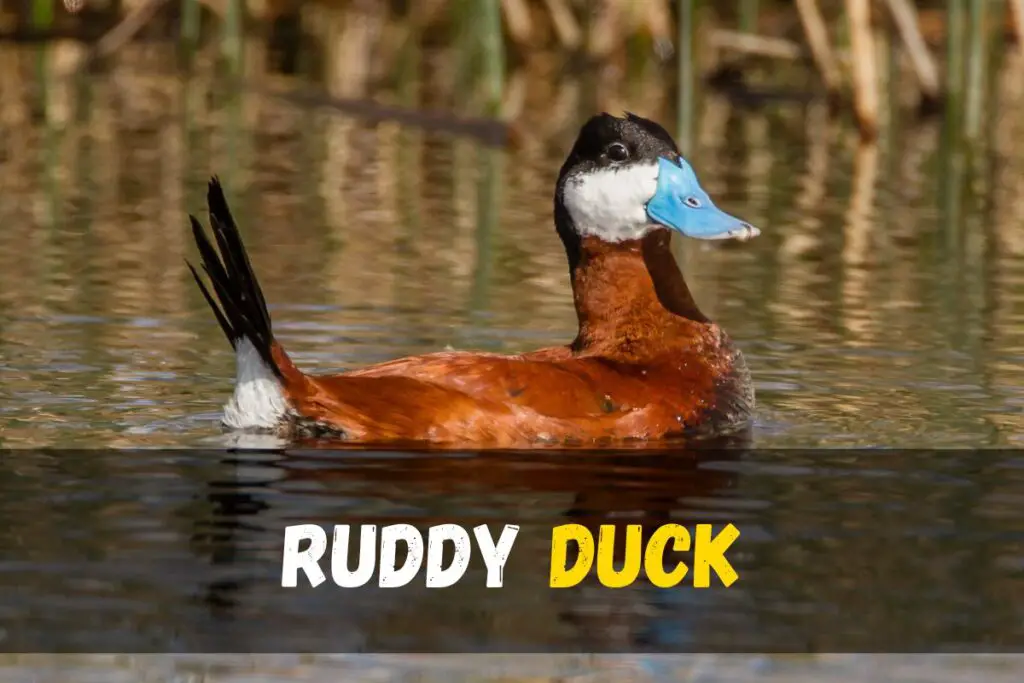
Originating from North America, Ruddy Ducks also inhabit parts of Europe due to their introduction to England in the 1930s and 1940s as captive species. They have successfully adapted and thrived in European environments from the 1950s to the 2000s, raising concerns about their impact on the native White-Headed Duck population. The interbreeding between Ruddy Ducks and White-Headed Ducks in Europe has led to the endangerment of the latter.
Key Information:
- Ruddy Ducks have a distinctive appearance, with males featuring a black cap, white cheek patch, rufous body, and a blue bill during the breeding season.
- Female Ruddy Ducks resemble non-breeding males but with a brown cap, a white cheek, and a brown horizontal stripe.
- The species’ introduction to Europe has raised conservation concerns due to their impact on the native White-Headed Duck population.
Food:
Ruddy Ducks primarily feed on a diet that includes aquatic plants, invertebrates, and small fish. Their foraging habits are adapted to their aquatic environments, where they dive to obtain food beneath the water’s surface.
Nesting:
During the breeding season, Ruddy Ducks create nests in wetland areas, utilizing vegetation and other materials to construct their nests. The nesting sites are chosen with care, often in concealed locations to protect the eggs and ducklings from potential predators.
Fulvous Behavior:
Ruddy Ducks exhibit notable behavioral traits, especially during the breeding season. Males display distinctive plumage and engage in courtship displays to attract females. The migration patterns, molting, and color changes in plumage contribute to the species’ dynamic behavior, adapting to different seasons and environments.
Ring-necked Duck
In Texas, one can frequently encounter the Ring-necked Duck (Aythya collaris), a medium-sized diving duck that spans 14 to 18 inches in length and weighs around 32.09 ounces. These ducks, with a wingspan of 24 to 30 inches, are common migrants in the region during the fall and winter seasons. The male Ring-necked Duck is characterized by a distinctive black head, a noticeable bump at the top, a black back and rump, a light gray body, and a white vertical splash between the body and the breast. The female, on the other hand, possesses a medium-gray back over a light brown body, along with a white eye ring and a white spot similar to the male.
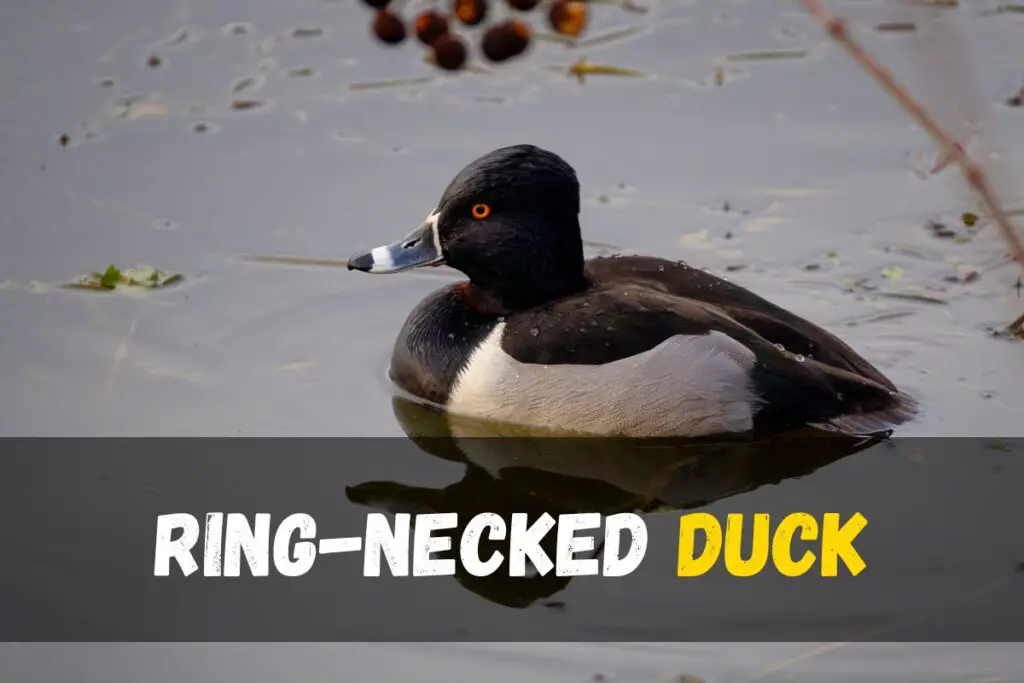
The Ring-necked Duck prefers nesting in woody-edged marshes and exhibits a diet primarily consisting of aquatic plants, clams, and snails. Notably, these ducks have a ring around their neck, although it is brown and challenging to discern from a distance. Interestingly, Ring-necked Ducks share similarities in appearance with Lesser and Greater Scaup, making it imperative to refer to additional information to distinguish between them.
Food:
Ring-necked Ducks are omnivores, with a diet predominantly comprising aquatic plants, clams, and snails. This diverse diet reflects their adaptation to freshwater environments, particularly woody-edged marshes, where they commonly nest.
Nesting:
The Ring-necked Duck displays a preference for nesting in woody-edged marshes. This choice of habitat aligns with their behavior of building nests in environments that offer a mix of water and vegetation, providing a suitable setting for breeding and raising their young.
Fulvous Behavior:
The Fulvous Behavior of Ring-necked Ducks includes their distinctive physical characteristics, such as the black head with a noticeable bump, and their nesting preferences in woody-edged marshes. Additionally, the ducks exhibit a specific foraging behavior, consuming a variety of food items ranging from aquatic plants to clams and snails.
Key Information:
Key information about Ring-necked Ducks in Texas includes their migratory patterns, with sightings being common during the fall and winter. The male and female ducks can be distinguished by their unique colorations and markings. Recognizing the challenges in identifying Ring-necked Ducks from other similar species like Lesser and Greater Scaup is essential for bird enthusiasts in the region. Their affinity for woody-edged marshes for nesting underscores the importance of preserving such habitats for the continued well-being of these medium-sized diving ducks.
Redhead
The Redhead duck, scientifically known as Aythya americana, is a captivating diving duck species native to Texas. Measuring between 18 and 22 inches in length, with a wingspan ranging from 29 to 35 inches, these ducks exhibit distinct physical characteristics. The male Redhead boasts a striking rufous head, a blue bill with a black tip, a gray body featuring a slightly rounded back, and a contrasting black chest and rump. In contrast, the female Redhead appears in a more subdued brown color, sporting a bluish-gray bill, and shares the rounded head and body shape with the male.
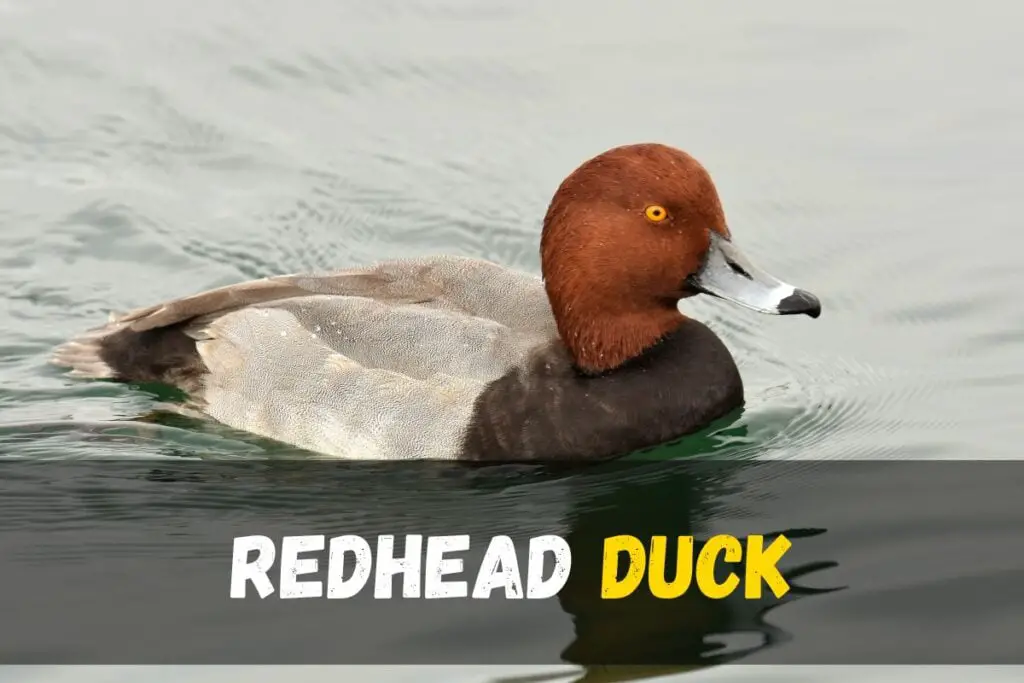
These ducks are not only visually appealing but also exhibit fascinating behaviors. Redheads are social birds often found in the company of other species such as the Ring-neck Duck, Lesser Scaup, Ruddy Duck, and Canvasback. They frequent lakes and bays, creating a picturesque scene amid mixed flocks.
Diet
Redhead ducks are omnivores, feeding on a diverse range of items. Their menu includes seeds, aquatic weeds, water lilies, grasses, and wild rice. Additionally, they indulge in mollusks, aquatic insects, and small fish, showcasing a varied and adaptable feeding behavior.
Nesting
Redheads are known to create nests in suitable habitats. The female Redhead plays a crucial role in building the nest, providing a safe space for the eggs. This nesting behavior is a vital aspect of their reproductive cycle.
Bufflehead
Buffleheads, scientifically known as Bucephala albeola, are captivating ducks with a distinctive appearance. Their length ranges from 13 to 16 inches, and they weigh approximately 21.16 ounces. The most noticeable feature is their big, round heads, which appear almost fluffy compared to the streamlined heads of many other ducks.
In Texas, Buffleheads are winter residents, primarily found along the Gulf Coast and near inland ponds. Texas holds a remarkable record, surpassing other states in the winter count of Buffleheads. At times, as many as 4,300 Buffleheads have been observed in the state during a single year.

Male Buffleheads exhibit an iridescent purple and green head with a prominent white block extending from the eyes to the back of the head. In contrast, females have a dark brown head with a distinctive white cheek patch. These ducks are known to be cavity dwellers but also display a preference for nest boxes.
Observing Buffleheads in their natural habitat can be both amusing and challenging. They resemble rubber ducks, bobbing up and down on the water. Interestingly, when they dive, there is always a sentinel or a group staying on the surface, making them challenging to count accurately.
Food:
Buffleheads have specific dietary preferences, although the provided text does not elaborate on their feeding habits. Generally, ducks like Buffleheads often consume a variety of aquatic plants, insects, small fish, and crustaceans.
Nesting:
While the text mentions that Buffleheads are cavity dwellers, it also highlights their affinity for nest boxes. Therefore, providing suitable nesting environments near streams, ponds, lakes, swamps, or marshes is essential for their reproduction and habitat sustainability.
Fulvous Behavior:
The term “fulvous behavior” is not explicitly addressed in the given content. However, it may refer to specific behaviors exhibited by Buffleheads, such as their bobbing movements on the water and their unique diving patterns.
Key Information:
Key information about Buffleheads includes their winter residency in Texas, their preference for the Gulf Coast and inland ponds, distinctive male and female characteristics, record-breaking population counts in Texas, cavity-dwelling habits, and the suggestion to provide nest boxes in their winter habitat.
Canvasback
In Texas, Canvasbacks (Aythya valisineria) are notable winter visitors, adding charm to the water bodies they inhabit. These large ducks boast a distinctive appearance with a sloping head, long, tapering black bill, and a striking red eye. The male Canvasback is particularly eye-catching during the breeding season, showcasing a chestnut-red head and neck, complemented by a black breast on a white body. In contrast, the female Canvasback exhibits a lighter brown hue in its head during the breeding season.

Canvasbacks, among the largest diving ducks, stand out not only for their size but also for their unique silhouette, especially noticeable in challenging lighting conditions. Their preference for small ponds as nesting sites adds to their intriguing behavior. During the mating season, the male Canvasback emits a peculiar hooting sound, creating a distinctive atmosphere in their habitats.
Food
Canvasbacks display a typical diving duck behavior, foraging beneath the water surface for aquatic plants and invertebrates. As winter visitors, their presence in Texas contributes to the rich avian diversity of the region.
Greater Scaup
In Texas, one can find the Greater Scaup, a species of diving duck known scientifically as Aythya marila. These ducks measure between 15-22 inches in length, weighing approximately 1.5-2.9 pounds, with a wingspan ranging from 28-33 inches. They are commonly observed in saltwater bays and lakes, especially during the winter months.
Distinguishing between the Greater Scaup and its counterparts, the Ring-necked Duck and Lesser Scaup, can be challenging due to their similar appearances. The male Greater Scaup is characterized by a black head with a greenish iridescence, a neck, and breast. Its back exhibits light gray barring on top of a white body, and a larger black rump. The female, on the other hand, features a white crescent around her bill, a dark-brown head, neck, and breast, a brown-gray body, and a slightly lighter brown back.

Identifying these ducks becomes even more complicated when they share the same body of water, often forming large flocks. The males of each species have distinct characteristics – the Ring-necked Duck with a black back, a black tip on its bill, and a white stripe between its face and bill; the male Lesser Scaup with a light gray back, no black tip on the bill, and a squarish black head with purplish iridescence; and the Greater Scaup with a rounded black head, green iridescence, and a slightly lighter gray back than the Lesser Scaup.
Interestingly, Greater Scaups are usually found in saltwater, while Lesser Scaups dominate freshwater habitats. Ring-necked Ducks, Lesser Scaup, and Greater Scaup collectively represent some of the most confusing species of ducks, requiring careful observation for accurate identification.
Behavior
Greater Scaups are known for their rounded heads, creating a distinctive appearance, almost as if they are slouching. Despite these challenges, the nuances in their physical features and behaviors can be better understood through the exploration of food habits, nesting preferences, and fulvous behavior.
Key information about these ducks includes their prevalence in Texas during winter, their cohabitation in the same water bodies, and the subtle differences that aid in identification. Whether in saltwater or freshwater, these ducks contribute to the rich avian diversity of Texas, making birdwatching a fascinating endeavor.
Sea Ducks (Diving Ducks) (8 Species)
Hooded Merganser
In Texas, one can encounter the unique and captivating Hooded Merganser, scientifically known as Lophodytes cucullatus. These ducks showcase distinct characteristics, with the males sporting a striking black and white, fan-shaped crest that can be lowered inconspicuously. Their body is predominantly black and white, accentuated by light brown sides. On the other hand, female Hooded Mergansers exhibit a shaggy cinnamon-brown crest, resembling the Common Merganser, and have few markings on their brown bodies. Notably, these birds are winter residents in most parts of Texas, except Big Bend Country in the western region.

Hooded Mergansers are renowned for their unique vocalizations, often earning them the endearing moniker “frog duck” due to sounds reminiscent of a pickerel frog. Beyond their visual and auditory distinctiveness, these resourceful ducks exhibit interesting nesting behaviors. They utilize old woodpecker holes as nesting sites, showcasing adaptability and resourcefulness in their reproductive habits.
Food:
Hooded Mergansers primarily feed on fish but also incorporate crustaceans and insects into their diet. This diverse food consumption highlights their adaptability to different food sources and contributes to their ecological role.
Nesting:
These ducks display resourceful nesting behavior, utilizing old woodpecker holes as nesting sites. This adaptive nesting strategy underscores their ability to make use of available resources in their environment for reproductive purposes.
Fulvous Behavior:
The Hooded Mergansers’ unique vocalizations, resembling the sounds of a pickerel frog, earn them the affectionate nickname “frog duck.” This distinctive behavior adds to the charm of these ducks and sets them apart in the avian landscape.
Key Information:
Key information about Hooded Mergansers in Texas includes their striking physical characteristics, winter residency patterns, unique vocalizations, resourceful nesting habits using woodpecker holes, and a varied diet that includes fish, crustaceans, and insects. Their adaptability and distinct features make them a noteworthy presence in the Texan avian ecosystem.
Red-breasted Merganser
The Red-Breasted Merganser, scientifically known as Mergus serrator, is a notable duck species found in Texas. These ducks are characterized by their size, with a length ranging from 16 to 26 inches and a wingspan of 31 to 35 inches. Red-breasted mergansers exhibit distinct features such as a shaggy crest, iridescent green heads for males, and cinnamon-brown crests for females with red eyes. Unlike Common Loons, another waterfowl species in Texas, Red-Breasted Mergansers are smaller and lighter-bodied, easily distinguishable by their thin bills.
In terms of behavior, Red-Breasted Mergansers are known for having what could be humorously described as the worst hair days in the Merganser family. The males often appear disheveled, resembling they’ve just gotten out of bed, while the females look windblown, as if they’ve driven cross country in a convertible, especially when wet.

These ducks have interesting habits and requirements. Red-breasted mergansers have specific nutritional needs, requiring an average of seventeen fish per day. To meet this demand, they dive an impressive 250-300 times daily. Notably, they hold the record as one of the fastest diving ducks, reaching speeds of up to 81 miles per hour during flight.
In terms of their presence in Texas, Red-Breasted Mergansers migrate throughout the state during the spring and fall. However, during winter, they are primarily found along the Gulf Coast, making it their wintering ground in Texas.
Key Information:
- Food: Red-breasted mergansers primarily feed on fish, consuming an average of seventeen fish per day.
- Nesting: Information about nesting habits is not provided in the given content.
- Fulvous Behavior: Information about fulvous behavior is not provided in the given content.
- Diving: Red-breasted mergansers are one of the fastest diving ducks, reaching speeds of up to 81 miles per hour. They are smaller and lighter-bodied compared to Common Loons, making them distinguishable by their appearance and behavior. Their wintering ground in Texas is along the Gulf Coast.
Common Goldeneye
The Common Goldeneye (Bucephala clangula) is a species of duck found in Texas, particularly in the northern regions during winter. These ducks exhibit distinct sexual dimorphism. Male Common Goldeneyes are primarily black and white, boasting an iridescent green head and a white spot beneath their eyes. On the other hand, females are mostly brown with a yellow-tipped bill and share striking golden-yellow eyes with their male counterparts.
Interestingly, these ducks showcase aggressive behavior towards each other, including females. During fights, ducklings may become separated from their original broods, forming a unique phenomenon called a crèche, where ducklings from multiple broods join together in a new nest.

Male Common Goldeneyes have a white body, black rump, and greenish-black iridescent heads. The females, in contrast, feature a light gray body, dark butt, and brown head. A distinctive characteristic of Common Goldeneyes is the broad white wing patch, prominently visible during flight. Notably, their wings create a metallic whistling sound while in flight.
In terms of distribution, Common Goldeneyes are winter residents in northern Texas, avoiding South Texas except for a small strip along the Gulf Coast. They are often observed in both freshwater and saltwater environments.
Food:
The specific dietary habits of Common Goldeneyes in Texas are not explicitly mentioned in the provided content. However, as diving ducks, they likely feed on aquatic invertebrates, small fish, and plant matter.
Nesting:
Details about the nesting habits of Common Goldeneyes in Texas are not extensively covered in the given content. Typically, ducks of this species create nests in tree cavities or nest boxes, and the females incubate the eggs.
Fulvous Behavior:
The term “fulvous behavior” is not explicitly mentioned in the content. It seems unrelated to the information provided about Common Goldeneyes in Texas.
Key Information:
Key information about Common Goldeneyes in Texas includes their winter residency in northern regions, avoidance of South Texas except along the Gulf Coast, distinctive male and female characteristics, aggressive behavior, the formation of crèches, and their presence in both freshwater and saltwater environments during Texas winters.
Common Merganser
In Texas, one can encounter various types of ducks, including the Common Merganser. Common Mergansers are surface divers commonly found in lakes and ponds. These ducks exhibit unique nesting behavior, with the female taking charge of finding a suitable cavity, often in a tree located about a mile from water and up to 100 feet in the air. The female meticulously prepares the nesting site, crafting a bowl shape using wood chippings or repurposing old squirrel nests, and then insulating it with her plucked feathers.
When it comes to their behavior, Common Mergansers are known for their delightful and leisurely lifestyle. They spend a significant amount of time floating, fishing, and even sleeping on the water. Interestingly, when one duck dives for food, others in the group tend to follow suit, creating a synchronized feeding pattern. These diving ducks have a preference for fish and aquatic creatures, utilizing their serrated bills to gain an advantage in foraging over other duck species.
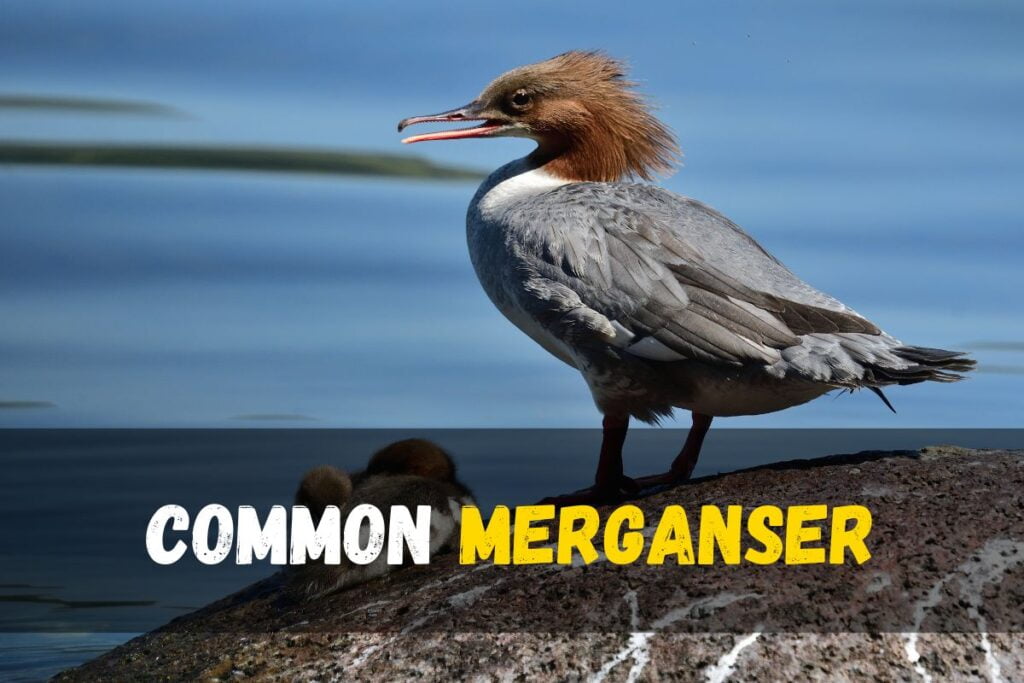
Male Common Mergansers in Texas are characterized by their streamlined appearance, featuring white bodies up to their necks and a distinct black stripe along their backs. Their heads showcase a beautiful greenish-black color, making their bright red bills a standout feature. These ducks, being among the largest members of the duck family, possess a slender build compared to counterparts like Eiders or Goldeneyes, with their narrow bills being a distinctive trait.
Key Information:
- Food: Common Mergansers primarily feed on fish, showcasing a preference for aquatic creatures such as crustaceans and mussels. Their serrated bills give them a notable advantage in securing food compared to other duck species.
- Nesting: The female Common mangoer takes sole control of finding a nesting site, choosing natural cavities in trees located a distance from the water. The nesting process involves crafting a bowl shape in wood chippings or old squirrel nests and insulating it with plucked feathers.
- Fulvous Behavior: While the provided content does not contain information specifically related to Fulvous behavior, it focuses on the behavior of Common Mergansers, emphasizing their leisurely lifestyle, synchronized feeding patterns, and unique nesting habits
Long-tailed Duck
The Long-Tailed Duck, scientifically known as Clangula hyemalis, is a unique and fascinating species found in Texas, although it is exceptionally rare in the state. These ducks exhibit a remarkable trait, undergoing a complete reversal of colors between summer and winter. During the winter months, male Long-Tailed Ducks are characterized by black and white plumage, with specific areas such as the shoulders, crown, forehead, neck, back, and belly appearing white. In contrast, the breeding season transforms these white areas into black, creating a striking visual shift. Female Long-Tailed Ducks, in winter, display a white head and brown body, but as summer approaches, their head turns brown while the body becomes white.

Long-tailed ducks are not only visually intriguing but also known for their distinct vocalizations. Described as yodeling, their calls are audible even before they come into view, making them an exciting bird to encounter in the Texan landscape. These ducks are recognized by their diving behavior, akin to little daredevils plunging into the water. Despite their rarity in Texas, dedicated birders in the state have reported sightings, expressing the desire to spot these captivating ducks.
Food:
Long-tailed ducks are likely to feed on a varied diet, which may include aquatic invertebrates, small fish, and plant matter. Their feeding habits contribute to their unique behaviors and appearances.
Nesting:
Details about the nesting habits of Long-Tailed Ducks in Texas are not explicitly mentioned in the provided content. However, like many waterfowl, they likely engage in nesting activities near water bodies, creating nests to protect their eggs and raise their young.
Fulvous Behavior:
The term “fulvous behavior” is not explicitly addressed in the given content. However, the description of Long-Tailed Ducks’ unique traits, such as their color reversal and yodeling calls, provides insight into their distinctive behaviors.
Surf Scoter
In Texas, one can find Surf Scoters, a distinctive species of sea ducks that stand out among their counterparts. These Scoters are most commonly observed during the winter months along the coastal areas, large lakes, and reservoirs. The males are easily identifiable by their all-black plumage with a white patch on the forehead and a larger one on the nape of the neck. What truly sets them apart are their heavy triangular, multi-colored, bulbous bills, especially noticeable among sea ducks.
The bills of male Surf Scoters appear orange from a distance but are intricately colored in black, white, red, and yellow upon closer inspection. Their unique wedge-shaped heads result from the bills being wider and puffier at the top, tapering towards the tip. Females, on the other hand, exhibit two distinctive white patches on their faces, with one being long and narrow in the front, and the other situated behind and beneath the eye.
Surf Scotters prefer areas where breaking waves occur, positioning them closest to the shore. Their feeding habits involve diving for crustaceans, mollusks, small fish, and aquatic vegetation. An interesting historical note is that Surf Scoters were once known by the name “Skunk Head.”
Key Information:
- Food: Surf Scoters primarily feed on crustaceans, mollusks, small fish, and aquatic vegetation.
- Nesting: The nesting behavior of Surf Scoters is not explicitly mentioned in the provided content.
- Fulvous Behavior: The behavior of Fulvous ducks is not discussed in the given content.
- Interesting Facts & Notes: An old name for the Surf Scoter used to be “Skunk Head.”
Black Scoter
The Black Scoter, scientifically known as Melanitta Americana, is one of the notable types of ducks found in Texas, particularly during the winter months along Texas’s Gulf Coast. These ducks exhibit distinctive features that vary between males and females. The male Black Scoter stands out with its entirely black plumage, including eyes and legs. Its most intriguing characteristic is the thick black bill, adorned with a bright orange bulbous bulge at the base. On the other hand, the female Black Scoter also possesses a thick bill, but without the distinctive bulge. Her body is characterized by light brown and dark brown mottling, with a dark brown top of the head and gray cheeks.

When it comes to their behavior, Black Scoters are winter residents along Texas’s Gulf Coast. Their diet is diverse and includes various saltwater creatures such as mollusks, shrimp, and shellfish. In freshwater environments, they consume fish larvae, fish eggs, and aquatic plants. This highlights their adaptability to different ecosystems.
Food:
The Black Scotter’s diet is primarily composed of saltwater creatures, emphasizing their reliance on the marine environment. Mollusks, shrimp, and shellfish constitute their main food sources. However, in freshwater habitats, their diet shifts to include fish larvae, fish eggs, and aquatic plants, showcasing their versatility in adapting to different food sources based on the environment.
Nesting:
While specific details about nesting are not provided in the given content, it’s known that ducks, including the Black Scoter, typically build nests on the ground in concealed locations. The female takes the lead in selecting the nesting site and incubating the eggs, emphasizing the importance of secure and hidden locations for successful reproduction.
Fulvous Behavior:
The term “fulvous” is not explicitly mentioned in the provided content. If it refers to a specific behavior or characteristic related to the Black Scotter, additional context or information would be needed to address this aspect.
White-winged Scoter
The White-Winged Scoter, scientifically known as Melanitta deglandi, is a notable species of duck found in Texas. These ducks are characterized by their size, with a length ranging from 19 to 24 inches (48 to 61 cm), a weight of 62.4 ounces (1768 g), and a wingspan between 33 and 41 inches (84 to 104 cm). They are often observed along the oceanic coasts of North America, from Galveston to South Padre Island.
In Texas, the White-Winged Scoter exhibits distinct features, with both males and females sharing a similar appearance. The male is distinguished by a “reverse comma” pattern over its eyes and a long white stripe down its wings. On the other hand, females are predominantly dark brown, almost appearing black, with a small white cheek patch.

Regarding their behavior, White-Winged Scoters, like other Scoters, breed in the far northern regions of Canada and migrate to winter along the coastal areas of North America, including Texas. These ducks are known for their unique bill structure, which is thick near the base and thinner at the tip, resembling that of the Surf Scoter.
Food:
The dietary habits of White-Winged Scoters in Texas are aligned with their oceanic habitat. They are known to feed on a variety of aquatic organisms, including fish, crustaceans, and mollusks. Their diet is adapted to the coastal ecosystem, reflecting their wintering grounds along the oceanic coasts.
Nesting:
White-Winged Scoters engage in nesting behaviors typical of ducks. They build nests in the far northern reaches of Canada during the breeding season. The nests are often constructed in concealed locations on the ground and are lined with down feathers for insulation. The female takes the lead in incubating the eggs, showcasing a typical avian reproductive strategy.
Fulvous Behavior:
The Fulvous Behavior of White-Winged Scoters in Texas involves their distinctive courtship and mating rituals. Males may display their “reverse comma” pattern during courtship, and both males and females participate in establishing pair bonds. Fulvous behavior is crucial during the breeding season and contributes to the reproductive success of the species.
Other Ducks (2 Species)
Black-bellied Whistling-Duck
In Texas, the Black-bellied Whistling duck is a distinctive type of duck known for its unique characteristics. These ducks possess long necks, bright dark pink to red bills, and long pink legs and feet. Both males and females share similar features, exhibiting chestnut bodies, gray faces, and striking black bellies. Juveniles, distinguished by browner bodies, have black bills and pale legs.
During the flight, Black-bellied Whistling-Ducks display a white patch on their upper wings, visible as a stripe down the wing when not in motion. Notably, their large pink legs trail behind their bodies, and they tend to fly with heads and necks lower than their body lines, making them easily identifiable.

An interesting behavior of these ducks is observed in their nesting habits. Females often lay their eggs in other Whistling-Duck nests, a phenomenon known as “egg dumping.” This behavior adds an intriguing aspect to their reproductive strategy.
It’s worth noting that the South American Black-bellied Whistling duck, scientifically classified as Dendrocygna autumnalis, has a distinguishing pale gray-brown band between the neck and the belly, contributing to its unique features.
Key Information:
- Food: While specific details about their diet in Texas may vary, Black-bellied Whistling-Ducks are known to consume a variety of aquatic vegetation, seeds, and insects.
- Nesting: The nesting behavior involves not only the creation of their nests but also the intriguing practice of laying eggs in the nests of other Whistling-Ducks, referred to as “egg dumping.”
- Fulvous Behavior: The term “fulvous” is not explicitly mentioned in the provided content. However, the ducks’ behavior, particularly their nesting habits and distinct physical characteristics, adds depth to their overall behavior.
Fulvous Whistling-Duck
The Fulvous Whistling-Duck, a large-sized bird with unique proportions, is a distinctive species found abundantly in Texas, particularly along the coast. Its body features a rich caramel-brown and blackish shade, complemented by slender white stippling on one side of its neck. Males and females can be distinguished by the presence of a black hue on the crown of females.

These ducks prefer warm freshwater marshes and are commonly spotted in rice fields, where they forage for food. They exhibit summer residency, appearing from mid-February to May. Notably, the Fulvous Whistling duck was once referred to as a tree duck due to its habit of roosting in trees.
In terms of behavior, these ducks are vocal, emitting descending whistles with a stuttered start. Flocks of Fulvous Whistling-Ducks are often heard soaring over feeding spots during dusk and dawn. Additionally, they occasionally dive into deep water. The vocalizations differ between genders, with females producing relatively squeakier sounds, while males enunciate a wheezier voice.
Food:
The Fulvous Whistling-Duck primarily forages for food in rice fields. Their diet likely includes aquatic vegetation and insects found in the marshy environments they inhabit. Their behavior indicates a preference for an ideal water depth in rice fields, showcasing their adaptability to different aquatic environments.
Nesting:
While the provided content does not explicitly mention nesting behavior, it can be inferred that these ducks may engage in nesting activities in or near the marshy areas they frequent. Details about nesting habits, such as the construction of nests and the incubation period, would require additional information.
Fulvous Behavior:
The behavior of Fulvous Whistling-Ducks is characterized by their vocal nature, with distinct calls that include descending whistles with a stuttered start. They are often seen and heard in flocks soaring over feeding spots during the transitional periods of dusk and dawn. The mention of their occasional dives into deep water suggests adaptability to various aquatic environments.


